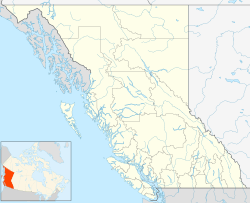Lax Kw'alaams facts for kids
Quick facts for kids
Lax Kw'alaams
|
|
|---|---|
|
District municipality
|
|

Lax Kw'alaams backdropped by the Kitimat Ranges
|
|
| Country | |
| Province | |
| Regional district | North Coast |
| Established | 1834 |
| Area | |
| • Total | 109.3 km2 (42.2 sq mi) |
| Population
(2016)
|
|
| • Total | 646 |
| • Density | 5.910/km2 (15.308/sq mi) |
Lax Kw'alaams, once known as Port Simpson, is an Indigenous village community in British Columbia, Canada. It is located near the city of Prince Rupert. The village is part of the Port Simpson Indian Reserve No. 1. This reserve is shared by several communities of the Tsimshian Nation. The Nine Allied Tribes living here are: Giluts'aaw, Ginadoiks, Ginaxangiik, Gispaxlo'ots, Gitando, Gitlaan, Gits'iis, Gitwilgyoots, and Gitzaxłaał.
Contents
History of Lax Kw'alaams
Lax Kw'alaams gets its name from Laxłgu'alaams. This old name means "place of the wild roses." It was a traditional camping spot for the Gispaxlo'ots tribe long ago.
Early Trading Post
In 1834, the Hudson's Bay Company (HBC) built a trading post here. They called it Fort Simpson, and later Port Simpson. The fort was named after Captain Aemilius Simpson. He was a superintendent for the HBC's Marine Department. In 1830, he had set up the first Fort Simpson on the nearby Nass River.
The HBC built Fort Simpson to compete with American traders. These American traders were very active in the Maritime fur trade along the Pacific Coast. The first leader of the new Fort Simpson was Dr. John Frederick Kennedy. He married the daughter of Chief Ligeex of the Gispaxlo'ots. This marriage helped build good relations and establish the fort on Gispaxlo'ots land. Kennedy worked at Fort Simpson until 1856.
Missionaries and Schools
In 1857, a missionary named William Duncan brought Christianity to Lax Kw'alaams. He felt the fort was not a good place for his Tsimshian followers. So, he moved with over 800 people to Metlakatla, a place to the south. Later, they moved to Annette Island, Alaska. There, he got permission from the U.S. Congress to create an Indian reservation.
Lax Kw'alaams did not have missionaries again until 1874. That's when Reverend Thomas Crosby of the Methodist church arrived. Today, the community is still mostly Methodist, now part of the United Church of Canada. Crosby's wife, Emma Crosby, started the Crosby Girls' Home in the 1880s. This home became part of British Columbia's Canadian Indian residential school system in 1893. It closed in 1948.
Community and Rights
In 1931, the Native Brotherhood of British Columbia was formed in Port Simpson. This was the first organization run by Native people in the province to fight for their rights. Four people founded it, including Tsimshian expert William Beynon and hereditary Chief William Jeffrey.
In 1857, William Duncan estimated the population of Lax Kw'alaams was 2,300 people. They lived in 140 houses. About 500 people died soon after Duncan left, during the 1862 Pacific Northwest smallpox epidemic.
Today, Lax Kw'alaams is the largest of the seven Tsimshian village communities in Canada. In 1983, its population was 882. By 2009, the Lax-kw'alaams First Nation had 3,219 members. In 2011, 678 people lived on the reserve. There are about 10,000 Tsimshian people in British Columbia. They are the largest Indigenous group in the province.
The Allied Tsimshian Tribes Association represents the people of Lax Kw'alaams. This group works with the government for the rights of the Nine Tribes. The Tsimshian people have a matrilineal system. This means that property and family lines are passed down through the mother's side of the family. Hereditary chiefs also come from the maternal lines.
In 2016, a study linked the genes of ancient Indigenous people to their descendants in Lax Kw'alaams. These ancient people lived near modern-day Prince Rupert, British Columbia between 1,000 and 6,000 years ago.
The name Port Simpson was given after Captain Aemilius Simpson. He was a distant relative of Sir George Simpson.
Notable People from Lax Kw'alaams
Many talented people come from Lax Kw'alaams, including:
- Frederick Alexcee, an artist
- William Beynon, a hereditary chief and expert on cultures
- Alfred Dudoward, a hereditary chief
- Bill Helin, an artist
- Chief William Jeffrey, a hereditary chief, carver, and activist
- Odille Morison, a linguist and collector of artifacts
- Reverend William Henry Pierce, a missionary and writer
- Terry Starr, an artist
- Henry W. Tate, a storyteller of oral history
- Arthur Wellington Clah, a hereditary chief and diarist
Images for kids




